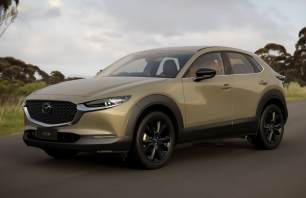The Corolla is a small car and that is evident inside. You might bump elbows with your front passenger, but I have no problem with the front leg or headroom.
Those cloth seats might be drab but boy they are comfy, and the fronts have loads of side bolstering.
The steering wheel has typically clear controls and looks and feels nice.
As a more, shall we say seasoned model in the segment, the Corolla still has buttons on the dash for things like air con, but not too many. That bulbous centre stack and the centre console, however, could be better designed for the space.
As it is, the wireless charging pad is hidden under it at the far end of the console. It’s a bit fiddly to get your phone in and out. This is also where one of the USB-C ports lives.
The other one is in the central storage bin which is quite small, but also houses a 12-volt outlet. There are no other places to store things because of the rounded shape of the console, which also features a couple of narrow cupholders.
OurCarsGuide bottle had to be squeezed into the door storage cavity - only narrow, short vessels will fit properly.
That 8.0-inch multimedia screen is very easy to navigate, with logical menus and icons. However, it’s almost too basic, which is not helped by the all-white background. It could be a more engaging set-up but it’s also very hard to fault the functionality. Our Apple CarPlay maintained its connection the whole time with the car, too.
Space is quite tight in the rear, although I have enough headroom for my 184cm frame. Legroom is just okay behind my driving position. There’s more space in the back of a Hyundai i30. It’s also dark because of smallish rear windows and thick C-pillars.
The rear seat backrest is quite upright, but, like the front seats, well cushioned.
Amenities are just average back there - there’s a weird cupholder high on the door, only a passenger side map pocket, no rear air vents and no USB ports, although you could easily use the one housed in the front central bin. There’s a rear fold-down armrest with two cupholders.
The rear seats split and fold 60/40 and they fold flat making for a better loading space.
The good news is the SX (and the base Ascent Sport) come standard with a temporary spare wheel, which is great news for a hybrid model. The bad news is, that reduces boot space to a paltry 217 litres.
That’s off the pace of all of its key hatchback rivals, including the Mazda3 which has its own cargo concerns at 295L, and the Hyundai i30 with 395L.
The Corolla ZR hatch has more space at 333L but you only get a tyre repair kit instead of a temporary spare.
If you’re dead set on a Corolla but need more cargo space, consider the smart looking sedan that has 470 litres.

